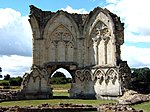North Killingholme Haven
Economy of LincolnshireHarv and Sfn no-target errorsHistory of LincolnshirePorts and harbours of LincolnshirePorts and harbours of the Humber

North Killingholme Haven is a water outlet on the south bank of the Humber Estuary in the civil parish of North Killingholme, to the north-west of the Port of Immingham. The area was used at the beginning of the 20th century for clay extraction with a jetty transhipping clay to Hull; in 1912 construction of a jetty for the Admiralty was consented, for fuel oil shipment. During the First World War a large seaplane facility was operated, known as RNAS Killingholme. In the 1990s a Simon Group established a Roll on-Roll off river terminal at the Haven, known as Humber Sea Terminal; the terminal was expanded to six berths through the 1990s and 2000s.
Excerpt from the Wikipedia article North Killingholme Haven (License: CC BY-SA 3.0, Authors, Images).North Killingholme Haven
Haven Road,
Geographical coordinates (GPS) Address Nearby Places Show on map
Geographical coordinates (GPS)
| Latitude | Longitude |
|---|---|
| N 53.6642 ° | E -0.2352 ° |
Address
Haven Road
DN40 3LA
England, United Kingdom
Open on Google Maps









